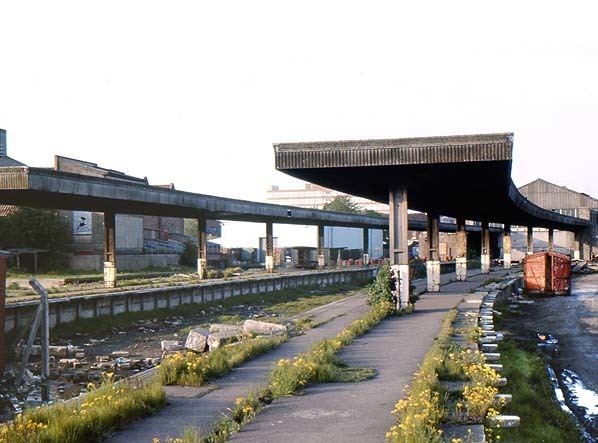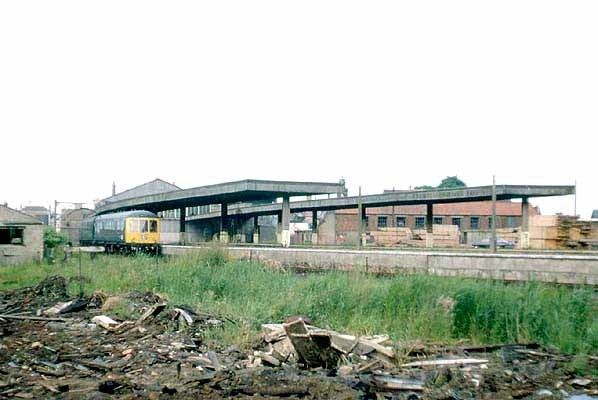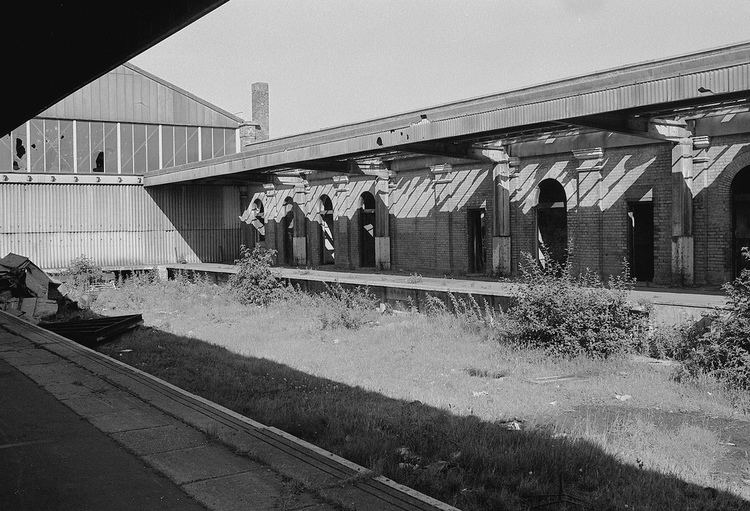6 November 1967 Closed to freight Platforms in use 4 1 June 1859 Opened | Grid reference TG520073 1 June 1859 (1859-06-01) Opened Original company East Suffolk line 4 May 1970 Closed to passengers | |
 | ||
Post-grouping London and North Eastern RailwayEastern Region of British Railways Similar Haddiscoe High Level railway st, St Olaves railway station, Gorleston‑on‑Sea railway station, Spinks Lane railway st, Aldeby railway station | ||
Yarmouth South Town, sometimes known as Yarmouth Southtown, was a railway station in Great Yarmouth, England, that is now closed. It was one of three major stations in the town, the others being Yarmouth Vauxhall and Yarmouth Beach, of which only Yarmouth Vauxhall now remains.
Contents
- Description
- Opening and early years
- London and North Eastern Railway 1923 1947
- British Railways 1959 1970
- Subsequent use of the site 1970 present day
- References

Description

The station had four platforms linked together at the east end by a generously sized circulation area. The main station building was built in the Italianate Style and other buildings were located along platform 1. There was a generously sized goods yard and a map of 1928 indicates a nearby coal yard, a nearby cattle market and timber yard. The railway was extended eastwards along the back of platform 1 to the quayside area with this area being shunted by horses or tractors as locomotives were forbidden to cross the road (now the A12) by the original 1856 act. This area contained a tightly spaced network of sidings linked by wagon turntables. As well as a traffic from the quayside there was (according to the 1928 map) a saw mill, corn mill and an icehouse all served by rail.

The station had small 2-road engine shed located south of the station area with a turntable, coaling and watering facilities. Some repair work was carried out here, despite the facilities being rudimentary. The shed closed in November 1959 when the line to Beccles was closed.
Opening and early years

Yarmouth South Town station was the northern end of the East Suffolk Line which opened on 1 June 1859 linking Ipswich with Yarmouth South Town station. From opening the line was operated by the Eastern Counties Railway(ECR) although the East Suffolk Railway continued to exist until 1862. By the 1860s the railways in East Anglia were in financial trouble, and most were leased to the Eastern Counties Railway. Although they wished to amalgamate formally, but could not obtain government agreement for this until 1862, when the Great Eastern Railway (GER) was formed by amalgamation.

During this period of operation there were express services to Liverpool Street (generally calling at Beccles where carriages from Lowestoft were added) and then other main stations and an all stations service to Beccles and Halesworth.
In 1872 the addition of a curve at Haddiscoe High Level allowed a direct all stations service to run to Lowestoft.
At the beginning of the 20th century a line was built from Yarmouth South Town to Lowestoft via Gorleston and opened in 1903. The Norfolk and Suffolk Joint Railway was jointly owned by the Great Eastern Railway and Midland and Great Northern Railway and served intermediate stations. Its primary function was to aid the development of the area as a resort although it also offered a more direct route from Lowestoft. There was also a link line which linked this line to Yarmouth Beach railway station to facilitate traffic between the two systems and this crossed the East Suffolk route just south of Yarmouth South Town.
Despite the opening of the new railway and more services to Lowestoft the service via Haddiscoe still operated. In November 1914 the original 45 foot turntable was replaced by a 65-foot turntable allowing more powerful steam locomotives ( GER Class S69 4-6-0) to operate the express services to and from London Liverpool Street.
During the First World War reduced passenger services operated to and from South Town
London and North Eastern Railway 1923 - 1947
On 1 January 1923 the railways in the UK were amalgamated into four companies and the GER became part of the London and North Eastern Railway.
A 500 kg bomb fell on the station on 7 May 1942 but failed to explode. A naval bomb disposal officer who had been at the station waiting for his train promptly defused the bomb. The station signal box was also damaged in 1942 and was replaced the following year by a new structure.
British Railways 1959-1970
Following nationalisation of the railways the station was operated by British Railways Eastern Region. The nationalisation era started brightly for the station with a dedicated named service - the Easterling - commencing operation on 4 July 1950. The station was by this time looking quite woebegone so a modernisation programme to improve it was started in 1952. Work included replacing the entrance canopy, cutting back and re-roofing the train shed, installation of new platform canopies, a new refreshment room, and a new booking office.
The station was closed for three weeks following the east coast floods of 31 January 1953 when the platforms and engine sheds were flooded to a depth of four feet . A signalman was marooned for 21 hours until rescued by boat. When the shed was cleared, the carcasses of 49 pigs, two calves and countless chickens along with timber from the nearby timber yard and other flood related detruitus were discovered.
On 21 September 1953 the line that linked Gorleston with Yarmouth Beach station was closed and from that point all Lowestoft trains terminated at South Town rather than some previously terminating at Beach.
As early as 1955 the British Transport Commission had identified the line north of Beccles to Great Yarmouth as a candidate for closure with all trains being diverted via Lowestoft. One of the reasons for this was that there were a number of swing bridges on the route that were expensive to maintain and there was a parallel route via Gorleston.
For some years in the late 1950s Bird’s Eye sent out food in containerised wagons from the station goods yard.
The line to Beccles closed on 2 November 1959 and all services between Lowestoft and Great Yarmouth operated over the later 1903 line. Expresses still served the station but from 18 June 1962 these were diverted to Yarmouth Vauxhall station.
The station was proposed for closure under the Beeching Axe. In the mid-1960s it was destaffed and its four platforms reduced to one operational platform (the former platform 4).
Freight facilities were withdrawn from the quayside area on 6 January 1967 and completely on 6 November 1967.
The station was eventually closed on 4 May 1970 with the last departure being an all stations service to Lowestoft.
Subsequent use of the site (1970-present day)
The old station was used as the headquarters of an oil company before being demolished in the 1980s to make way for the A12 link road. The A12 follows the route of the railway until just past Gorleston railway station. On the site of the old yards are Homebase, Matalan and Lidl stores.
A bench from the station, bearing the station name, is on display at the National Railway Museum, York.
